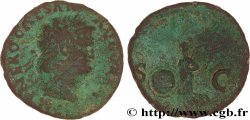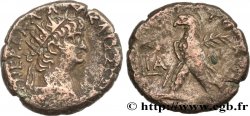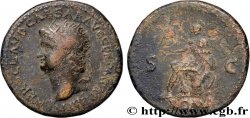v50_0008 - NERONE Aureus
MONNAIES 50 (2011)
Prezzo di inizio : 3 500.00 €
Valutazione : 5 500.00 €
Prezzo realizzato : 4 755.00 €
Numero di offerte : 3
Offerta maxima : 4 820.00 €
Prezzo di inizio : 3 500.00 €
Valutazione : 5 500.00 €
Prezzo realizzato : 4 755.00 €
Numero di offerte : 3
Offerta maxima : 4 820.00 €
Tipo : Aureus
Data: c. 64-65
Nome della officina / città: Roma
Metallo : oro
Diametro : 18,5 mm
Asse di coniazione : 9 h.
Peso : 7,33 g.
Grado di rarità : R2
Commenti sullo stato di conservazione:
Exemplaire sur un flan légèrement ovale avec les grènetis visibles. Magnifique portrait de Néron de haut relief, bien venu à la frappe. Représentation iconographique de première importance de style fin. Magnifique patine de collection ancienne avec une coloration rougeâtre, caractéristique, souvent nommée “patine de Boscoreale”. Conserve une partie de son brillant de frappe
N° nelle opere di riferimento :
Pedigree :
Cet exemplaire provient de la vente Weil du 20 mars 2003, n° 31. Vue la couleur de l’or caractéristique, il provient peut-être du trésor de Boscoreale (Italie) découvert en 1895 et enfoui au moment de l’éruption du Vésuve en 79 avant J.-C
Diritto
Titolatura diritto : NERO CAESAR - AVGVSTVS.
Descrittivo diritto : Tête laurée de Néron à droite (O*).
Rovescio
Titolatura rovescio : IANVM CLVSIT PACE P R TERRA MARIQ PARTA.
Descrittivo rovescio : Les portes fermées du temple de Janus.
Traduzione rovescio : "Ianum Clusit Pace Populo Romano Terra Marique Parta" (Il a fermé le temple de Janus après avoir donné la Paix au Peuple Romain sur terre et sur mer).
Commento
Un seul ruban visible à l’extrémité bouletée. Le trésor de Bosco Reale (près de Pompéi) fut découvert dans un pot sur le terrain d’une grande villa latifundiaire à la fin du XIXe siècle (en 1894 ou 1895). Il aurait contenu plus de 1.000 aurei et fut dispersé. Les pièces les plus récentes sont datées de 78 et le trésor aurait été enfoui au moment de l’éruption du Vésuve en 79. Les fouilles de la villa ne débutèrent qu’en 1876. Malheureusement, nous n’avons pas d’inventaire précis de la trouvaille malgré la recension d’Adrien Blanchet dans la Revue Numismatique dès 1895 (p. 574-575). Les publications plus tardives comme celle de C. Canessa en 1909 incluent peut-être des pièces qui n’appartenaient pas au trésor. Souvent dans les catalogues est évoquée la patine de “Boscoreale”. La teinte des aurei de ce trésor est bien particulière, rougeâtre, caractéristique, due peut-être aux conditions de l’enfouissement et de l’éruption volcanique. Ce type de pièces apparaît parfois dans de vieilles collections proposées à la vente.
A single ribbon visible at the rounded end. The Bosco Reale treasure (near Pompeii) was discovered in a pot on the grounds of a large latifundia villa at the end of the 19th century (in 1894 or 1895). It is said to have contained more than 1,000 aurei and was dispersed. The most recent coins are dated 78 and the treasure is said to have been buried at the time of the eruption of Vesuvius in 79. Excavations of the villa did not begin until 1876. Unfortunately, we do not have a precise inventory of the find despite Adrien Blanchet's review in the Revue Numismatique as early as 1895 (pp. 574-575). Later publications such as that of C. Canessa in 1909 may include coins that did not belong to the treasure. The patina of “Boscoreale” is often mentioned in the catalogs. The color of the aurei in this treasure is very particular, reddish, characteristic, perhaps due to the conditions of burial and the volcanic eruption. This type of piece sometimes appears in old collections offered for sale.
A single ribbon visible at the rounded end. The Bosco Reale treasure (near Pompeii) was discovered in a pot on the grounds of a large latifundia villa at the end of the 19th century (in 1894 or 1895). It is said to have contained more than 1,000 aurei and was dispersed. The most recent coins are dated 78 and the treasure is said to have been buried at the time of the eruption of Vesuvius in 79. Excavations of the villa did not begin until 1876. Unfortunately, we do not have a precise inventory of the find despite Adrien Blanchet's review in the Revue Numismatique as early as 1895 (pp. 574-575). Later publications such as that of C. Canessa in 1909 may include coins that did not belong to the treasure. The patina of “Boscoreale” is often mentioned in the catalogs. The color of the aurei in this treasure is very particular, reddish, characteristic, perhaps due to the conditions of burial and the volcanic eruption. This type of piece sometimes appears in old collections offered for sale.








 Segnalare un errore
Segnalare un errore Stampate la pagina
Stampate la pagina Condividi mia selezione
Condividi mia selezione Fai una domanda
Fai una domanda Consegnare / vendere
Consegnare / vendere
 Descrittivo
Descrittivo









